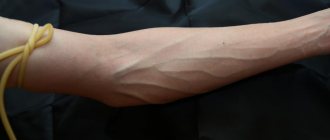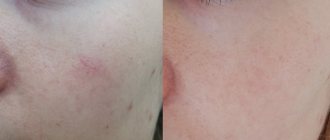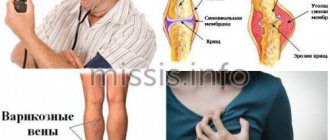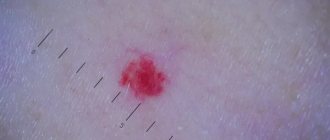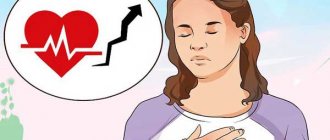Arsenyev Alexey Olegovich
Vascular surgeon, phlebologist, Ultrasound doctor
October 25, 2021
Of course, subcutaneous hemorrhage or bruising on the body can look unsightly and cause aesthetic discomfort. If this is an isolated situation, then, as a rule, there is nothing wrong with it. If the situation repeats: bruises occur in different places and, perhaps, complaints appear in other organs and systems (for example, pain in the heart, joints), then you should figure out why the vessels burst on the legs or body, as this may be a manifestation one of the more serious pathologies.
Causes of intradermal hemorrhages
- Domestic injury
Living under time pressure, a person is constantly in a hurry to get somewhere and sometimes does not notice how in the course of his actions he receives some minor injuries or bruises. There is a direct cause-and-effect relationship in this: injury - damaged/burst vessels in the legs - bruise. There will be no injuries - there will be no hemorrhages.
- Phlebeurysm
With this disease, moderate venous hypertension is created in the superficial venous system due to valve incompetence and the formation of blood stagnation in the veins. Along with this, there is already an overstretched, swollen vein (varix - from the Latin swelling), the wall of which becomes thinner (analogy: the more we inflate a balloon, the more likely it is to burst), at some point it cannot stand it and bursts. Therefore, if a vein is swollen in the temple, leg or body, then you need to contact a vascular surgeon/phlebologist. And together with the doctor, plan treatment - from simple lifestyle modification to surgery to remove large veins.
- Non-physiological loads
A modern girl can walk or stand in high heels for 8–10 hours a day, which, in turn, leads to a significant weakening of the mechanisms of venous blood outflow and an increase in venous pressure, hypertension in the legs. This may contribute to the appearance of a bruise. The best solution in this situation is to give up heels or at least reduce the duration of wearing them, increase the volume of dynamic load, which also helps venous outflow.
- Taking hormonal medications containing female sex hormones (including oral contraceptives)
The reason for prescribing hormonal drugs may be banal contraception, treatment of gynecological, dermatological or other group of diseases. These drugs contain female sex hormones, which, in addition to regulating the cycle and the formation of secondary sexual characteristics in women, also affect the vascular system: they provoke bruises on the legs, the vessels become brittle, their elasticity decreases, and the diameter of the veins increases. The decision to discontinue, replace the drug and treat increased vascular fragility is made only after an in-person examination of the patient and review of the medical history. In this case, therapy is carried out by gynecologists, vascular surgeons/phlebologists.
- Condition after respiratory infections
Most viruses (influenza, parainfluenza, coronavirus infection, ARVI) are tropic to vascular structures, and after a person has had one of them, bruises may appear on the body that were not there before. In this situation, the body needs to be given time to recover; you can also include in your diet foods rich in vitamin C (citrus fruits, kiwi, rose hips, sea buckthorn, black currants, parsley, broccoli, sweet red peppers, sauerkraut, etc.), vitamin P ( citrus fruits, buckwheat, black currants, rose hips, raspberries, tomatoes, beets, red bell peppers, asparagus, plums, etc.). It is possible to take synthetic analogues of these drugs, but before doing so, you must see a doctor.
- Vasculitis
A group of diseases that is accompanied by inflammation of the vascular wall, and sometimes by its increased permeability and fragility.
Vasculitis is divided into several types:
- Primary is an independent process in the vascular system, and not a consequence of the pathology of other organs. The group of primary vasculitis, accompanied by the appearance of bruises, includes: Wegener's granulomatosis, Churg-Strauss syndrome, microscopic polyangiitis, Henoch-Schönlein purpura, hypersensitivity vasculitis, cryoglobulinemic vasculitis, Behçet's disease, vasculitis in rheumatic diseases (systemic lupus erythematosus, rheumatoid arthritis, Sjögren), etc. In such cases, etiotropic therapy of the pathology, that is, treatment of the underlying cause, is carried out by a rheumatologist, and vascular surgeons/phlebologists, cardiologists, and dermatologists help treat the consequences of the disease.
- Secondary - there is another disease (oncological or infectious origin), against the background of which hemorrhages appear on the skin. One example is vasculitis against the background of exacerbation of viral hepatitis. This also includes the previously mentioned respiratory infections. With effective treatment of the underlying disease, bruising on the body disappears.
The most common reason for the appearance
The most common cause of hemorrhage is trauma to the skin and soft tissues.
Petechiae appear due to:
- soft tissue damage;
- pressing on clothing and its elements (straps, belts);
- rubbing the surface of the skin.
This creates high pressure, and the walls of the capillaries burst, releasing blood, which then spreads under the skin. This condition can also be caused by emotional stress, during crying or screaming. With age, all tissues of the body become less durable, so the occurrence of petechiae becomes more frequent.
Let's sum it up
The main causes of bruising and increased fragility of blood vessels are listed above, but not all of them. There are quite a few of them, and treatment tactics in each specific case can differ radically. Moreover, completely different specialists can treat pathology: vascular surgeons/phlebologists, dermatologists, rheumatologists, infectious disease specialists. It is impossible to give any general recommendations without seeing the patient and without knowing the entire clinical picture. From a relatively harmless, which can have an effect, and in most cases does not harm, we can recommend eating more foods rich in vitamin C, vitamins P, or taking their synthetic analogues. But even here, allergic reactions to these drugs and food are possible, and there are also restrictions for certain groups of patients (for example, pregnant women).
Cancers
The cause of a hematoma on the body without a bruise can be leukemia, that is, blood cancer. At the same time, the number of platelets, leukocytes and red blood cells in the blood decreases. Reduced blood clotting occurs with a lack of platelets. Because of this, even a very slight bruise can lead to severe and large hemorrhage.
Also, the cause of bruises on the body without contusions may be a decrease in blood clotting. In this case, you need to reconsider your diet. Vitamin K should be taken in increased quantities. It is found in lettuce leaves, nettle infusion and cabbage.
In addition, hematomas also occur due to the following diseases: rheumatism, kidney disease, chronic tonsillitis.
What to put on a bruise
In order for treatment for a bruise to be effective, it is necessary to take into account the time that has passed since the injury. The formation of a hematoma goes through several stages. Immediately after the injury, agents are used that relieve swelling. At home, at an early stage, you can use folk remedies, but after that, purchase pharmaceutical drugs.
On the first day, you can apply ointment or gel containing heparin to the bruise. It helps reduce swelling by increasing the speed of blood flow. Heparin is well absorbed through the skin, thins the blood and prevents the formation of a hematoma. Therefore, treatment of the bruise will proceed quickly.
But when using heparin, you need to remember that it is not recommended to use it in the first hour or two after a bruise. It can increase bleeding at the injury site and cause an enlarged hematoma.
If a soft tissue injury is accompanied by pain, it can be reduced with the help of non-steroidal anti-inflammatory drugs. Quickly relieve discomfort with a gel or ointment that contains diclofenac, ibuprofen or piroxicam. They can be applied to the impact site after a few hours.
After a day, these remedies for treating bruises are no longer effective. Blood permeates the tissues, coagulates, and its cells are destroyed. Therefore, the bruise turns blue due to the protein hemoglobin. From this moment, its disintegration and hematoma begins to bloom. She herself will not be able to pass in a short time until all hemoglobin is destroyed into bilirubin.
We need products that resolve bruises by heating the tissues and increasing blood flow in them. You can use dimethyl sulfoxide creams or ointments at home without a doctor's prescription. This substance is obtained from hot peppers, so it has a warming effect. Minor bruises after using it disappear within 2-3 days.
Methods for getting rid of bruises on the body
Currently, there are many different remedies for the treatment of hematomas. But if hematomas appear on the body for no reason, then external medications are unlikely to help in any way, since bruises will appear again and again. In this case, you will have to eliminate the cause of the problem. Otherwise, hemorrhages may become even more extensive, and there is a high probability that they will affect organs, eye tissue and the brain. Therefore, if a large number of bruises appear on the body for no reason, you must consult a specialist and then undergo an examination, which includes various procedures and tests, as well as liver diagnostics and blood composition studies. Based on the results of the study, the doctor will make a diagnosis and prescribe the necessary treatment.
If there is a need to get rid of the external manifestation of a hematoma, then it is possible to use several methods. But you can carry out such manipulations yourself with the permission of a specialist.
So, to reduce the intensity of the bruise, you can use the following remedies:
- Troxevasin ointment. This drug will help eliminate bruises on the skin. Its active component affects blood vessels and fragile capillaries. To enhance the effect, you can take Troxevasin tablets simultaneously with this ointment.
- Heparin ointment, which helps dissolve the blood clot under the skin and speed up the resolution of bruised skin.
- Ointment "Rescuer". It helps remove bruises on the legs, arms and other areas except the eyes and lips.
Why is it so important to diagnose the body’s functioning when bruises appear?
The first of the listed reasons is particularly dangerous – disturbances in the functioning of the cardiovascular system. There are many diseases of this type, and some of them may be asymptomatic. There is another situation: an elderly person, seeing that many of his peers are suffering from cardiovascular diseases, believes that pain in the chest is something normal for his age, and is in no hurry to see a doctor.
In fact, all these diseases tend to progress, and many of them, if untreated, lead to death. Blue spots on the skin may indicate that the walls of blood vessels are thinning and losing elasticity. Any pressure surges are reflected by the appearance of hematomas.
At the same time, many older people have deposits in the form of atherosclerotic plaques. They aggravate the situation by a sharp change in the speed of blood flow. There are more gaps. Over time, blood vessels can become thinner not only in the arms or legs. Ultimately, the problem becomes broader: a cerebral stroke or myocardial infarction may occur.
It is from this that it is important to protect an elderly person. Modern medicine opens up wide opportunities for treating cardiovascular diseases or correcting the patient’s condition. This allows you to significantly extend life and improve its quality significantly.
Legs itch and bruises appear. What to do if your feet itch and bruise
| 12.11.14 13:00 |
If your legs itch and bruises appear, even though you haven’t fallen or hit them anywhere, then perhaps this is the first sign of a blood disease and it’s time to start thinking about your health. Be sure to consult a doctor if, even after slight contact with the skin, marks remain on it. One of the common causes of this skin condition is the onset of the initial stage of varicose veins. What to do if bruises appear on your legs?
Engaging in active sports or short walks will help prevent blood stagnation by improving blood circulation. If you don’t understand why your legs itch and then bruises appear, but you paid attention to this problem at the initial stage, you have every chance of quickly getting rid of an unpleasant illness. Always try to be on the move: stop using the elevator, get off first at the stop, walk often short distances, start running, sign up for a swimming pool, ride bicycles, and go to a ski resort in winter. But if, on the contrary, you are in a standing position for a large period of the day, then it is advisable, as soon as you have a free minute, try to sit more comfortably, while throwing your legs up. This way, your limbs will relax and blood circulation will normalize. A small massage will help eliminate spider veins on your legs. Take the cream, moisturize the skin, knead it in areas from the hips to the knees, then proceed to massage the shins of the lower legs. Massage your toes separately. Knead your foot in a circular motion, then rub the top of your feet and lower legs. If your legs itch to the point of bruising due to prolonged sitting at the computer, try to do the following:
Do special exercises for your knees and feet even while at work. (For example, rise on your tiptoes, lower your feet, and pull your toes towards you. Repeat this exercise several times). Causes of occurrence and prevention of subcutaneous hematomas
|
What does traditional medicine say?
If you turn to traditional medicine, you can find out many recipes with which yellow bruises will disappear in a matter of days. The most popular of them:
- Badyaga - dried seaweed, ground into powder. They are sold in every pharmacy. With their help, they make excellent lotions - the powder is diluted with water at room temperature in a 1:1 ratio, and especially bothersome bruises are rubbed with it. If you rub them 2 times a day, the yellowness, if not completely disappears, will decrease significantly.
- Potatoes are an excellent remedy in the fight against runny nose and viral infections. It can also help heal bruises. To do this, rub fresh potatoes and apply them to the hematoma. After the procedure is completed, the area is rinsed with water at room temperature.
- Herbal decoctions - coltsfoot, cornflower, chamomile, wild rosemary, linden blossom and celandine. After boiling water, add a teaspoon of herb and cook it for at least 10 minutes. Then you can turn off the fire and let the broth cool slightly. The finished tincture is filtered and used as needed. The most popular methods are to soak cotton pads with the tincture and apply them to the sore spots. Within a couple of days, the hematomas will completely disappear.
Now you know what yellow bruises are and how to get rid of them.
Bruises in children for no reason
Hematomas in children can form either as a result of their vigorous activity or without any special reason. The cause of bruises on the body without contusions in children may be the diseases mentioned above. Lack of vitamins also plays a role. In addition, hematomas without bruises in children may appear in the following cases:
- Worm infestation.
- Wrong diet.
- Violation of the daily routine.
- Hereditary fragility of blood vessels.
- Thyroid diseases.
- Little physical activity.
Injections can also cause bruises on the body without bruises on the child's skin. Hematomas are provoked by an injection and remain for a long period of time under the following conditions:
- Short needle on a syringe.
- The muscle reacts with spasm.
- Accelerated administration of medication.
- Allergy to the administered drug.
If hematomas appear on a child’s skin, it is imperative to consult a doctor to identify and eliminate the causes. You should pay special attention to the following symptoms of hematomas:
- Dizziness.
- Deterioration of vision.
- High body temperature.
- Difficulty walking or speaking.
- Drowsiness and weakness.
Bruises located on the back, head, back of the arms and in the eye area are very dangerous. In order to remove bruises on the body, you need to consult a doctor and carry out the necessary diagnostic procedures.
Specialists
| 5.0 106 reviews | Simonov Anton Borisovich Orthopedist 15 years of experience Doctor of the first category Admission from 2200 rub. |
| 5.0 764 reviews | Savchenko Sergey Vladimirovich Orthopedist Experience 37 years Doctor of the highest category Admission from 2200 rub. |
| 4.9 94 reviews | Alpaidze Georgy Zakharovich Orthopedist Experience 33 years Doctor of the first category Admission from 1900 rub. |
East Clinic in Mytishchi st. Borisovka, 20
Help with medicines
Bruises often appear closer to the eyes, puzzling the fair half of humanity. They go to doctors for help, who provide them with a wide selection of modern drugs. The leading places are occupied by:
- "Troxevasin". Hematomas disappear without a trace within the first couple of days. But despite this effectiveness, this medicine requires increased attention. Sore areas must be treated every 60 minutes. The medication breaks down yellow bruises, promoting rapid healing and strengthening blood vessels. In the absence of contraindications, it is recommended for the prevention of such formations.
- "Bruise-off." Contains leech extracts that can cure hematomas of varying severity, alleviating pain and swelling. A pleasant bonus will be the masking abilities of the ointment, hiding minor imperfections of the skin. But you will have to use this ointment especially often: doctors advise rubbing bruises at least five times a day.
- "Lyoton." Strengthens blood vessels, keeping all inflammatory processes in check.
- Heparion ointment. Improves blood clotting, helping to forget about swelling and inflammatory processes. Using it three times a day will provide excellent pain relief to any vulnerable spot.
